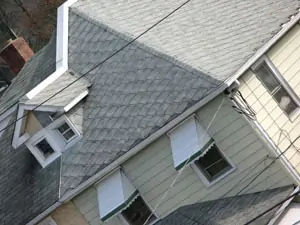By Mark Clement
I’m what you call a generalist when it comes to remodeling activities: If it’s made of wood or you nail/screw it down, I pretty much build or install it. This means when the call comes to do a roof, I usually say yes.
My custom builder and high-end remodeler friends, however, look at me like I have three eyes when I tell them that I’m taking on a roof project. “Why?” they ask. Surely they’re thinking of the often lower margins and highly physical work. Part of the answer is, of course, revenue. I’m in business to make money, and as a home-improvement contractor, that often results in working on just about every kind of project. But the other part of the answer might be a little darker: I like it.
It could be the adrenaline-addict rugby player in me trying to break a tackle and get out. It might be that I’m a little crazy. Or it might be that I’m seriously passionate about home improvement, which is true.
Whatever the reason, a customer called and told me their roof was leaking. What’s more, they couldn’t find a roofer who wanted to take on the project. See, in the “nothing’s ever easy in the land of old houses” department, this roof was really only half a roof—one side of what we call a “twin” near Philadelphia, and what most others call a duplex. For reasons no one ever gave me, other contractors wouldn’t touch it. So the customer called, and my dark side answered.
The re-roof job was hardly brain surgery. But it wasn’t a conventional roof, either. Because of that, it became more remodeling than straight roofing and therefore—like all good remodeling projects—took lots of forethought. Most of mine went to determining how to handle the 2 tons of roofing material that I would strip and dump in the yard, how to store the new shingles prior to installation, and how to keep the customer’s house dry during the tear-off. Ironically, putting on the new 30-year architectural shingles I had spec’ed for the job was the least of my worries.
Prepping the Site
If you haven’t done much roof replacement but are inclined to take one on, know this: Tearing off shingles is pervasively messy. Shingles break into little pieces, nails fly everywhere, and try as you might, the shingles don’t simply fall straight down off the edge of the roof. Instead, small chunks of shingle and paper catch an updraft and sail into the neighbor’s yard, nails get projected into the customer’s driveway, and heaps of falling asphalt-laden debris crush flower beds.
200 Feet of Black Plastic. To combat the total chaos that happens when you remove a roof system from the roof deck, I laid a 10-by-80-foot sheet of 3-mil black plastic around the base of the house. To do so, I cut the sheet from a 20-by-200-foot roll and folded the 20-foot dimension to create a double-layer, 10-foot wide length. It worked as a great gutter for almost everything that came off the roof.
Between Me and the Ground. Safety is pretty much my main concern once I’m on a roof. And this one was a strong 8-pitch roof, meaning it was barely walkable. To add insult to potential injury, the asphalt shingles crumbled underfoot, which amounts to walking on a layer of tiny ball-bearings. So I spent a lot of time working on my knees. My main priority was to keep something between me and the ground–to create a work platform. To that end I used The Roofers’ World Extreme Bracket, which I really liked. It’s easily adjustable and can brace a 2-by-10 or 2-by-12 board.
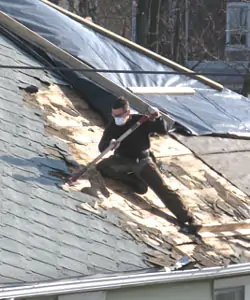
I also used my own version of a walk board I call an L-bracket. Now, this has hardly been vetted by OSHA, but it beats a 2-by fastened to the roof deck for footing, which I see all the time. And it’s simple: On my sites, I screw two 2-by-4s together in an L shape, and then screw them right down to the roof shingles or deck with 3-inch deck screws. Since the roof is coming off anyway, I don’t care about the holes this causes. I like using the L-bracket because if I drop a tool, the addition of the vertical 2-by-4 usually catches it, while I’ve seen roofing guns skate right over a plain ol’ 2-by walk board.
The L also provides surer footing, and I can lay a flat bar, cordless drill or shingle stripper on it without fear of a slight nudge pushing it off the roof. And as I move up the roof, the L-brackets are light and easy to re-position. I can also use them as a guide for rolling out tar paper.
Tools. I like that you don’t need many tools to tear off shingles. I used The Roofers’ World Red Ripper tear-off bar, and I really liked it compared to other strippers I’ve tried. I also ran the Bostitch RN-46 through the paces as my main nailer. I got the air that powered it from a Maxus X-Lite compressor, which was also aces. And I found a pair of safety glasses made by Head that I didn’t mind wearing all day. (I bought the glasses for cheap in the racquetball section at Dick’s Sporting Goods. Ironically, I don’t really like them for racquetball.) For cutting the shingles, I used the RoofMates Shingle Saw—what a time saver.
What do you get when you combine mangled “hurricane” shingles with 80+ year old asbestos tiles? You’re right: a roof that not only looks terrible but leaks. This one had to ripped down to the decking.Drop ‘Em
Two courses of shingles covered this roof, and neither one was conventional. Of course, this created a problem that I only discovered as I took the shingles off. This is one of the shortcomings of being a generalist—or jack of all trades—rather than an expert at a single phase. See, the original shingle layer was diamond-shaped asbestos tiles. Laminated over the asbestos were diamond-shaped asphalt shingles, referred to as hurricane shingles.

While you may be thinking the asbestos was the problem, it really wasn’t. The asbestos broke like a ceramic tile would—in big pieces and chunks. In other words, it didn’t pulverize, which is when that stuff gets really nasty. No, the problem was that as I tore off the shingles, I couldn’t find a clean line at which to stop at the end of the day. This meant there wasn’t a really great spot to tuck my plastic under as the sun went down. I managed, but it took some serious finagling, and I’m lucky it didn’t rain harder than it did at night.
Strip-Tease. I started out stripping from the top down, and this worked OK. In a couple of areas I stripped from the bottom up. This also worked OK.
When I attacked the shingles from the side, left to right, I started gobbling up huge chinks of material, easily doubling my output. I’m not saying a side-to-side tear-off works best on conventional roofing materials but it got me moving full-tilt here.
Bag ‘Em. There was no way to get a truck or dumpster anywhere near where the shingles left the house, much to my (and my aching back’s) dismay. This was the main reason for the plastic sheeting. I then used a coal shovel to load them into my new favorite demo tool—DemoBags. DemoBags are woven, re-usable/biodegrable-ish trash bags that are awesome. Unlike the 3-mil plastic contractor bags, you can load these puppies so heavy they’re hard to lift—perfect for nail-embedded shingles. I even dropped them off the roof loaded with stuff, and they didn’t burst. I then dragged the DemoBags into the driveway for haul-away later. And once I did haul the shingles to the dump I didn’t dump, I poured the shingles out and now have the bags staged for my next demolition job.
Damage Control
Nail Off. This particular roof deck had been through a zillion wet-dry/hot cold cycles. This causes the solid sawn wood deck to expand and contract (unlike an engineered product like plywood, which is much more stable through temperature and humidity changes). As a result, a lot of the nails that held down the 1-by sheathing had worked their way proud—and I even managed to pull a bunch of them out with the Red Ripper. Bottom line: The roof deck needed to be nailed in its entirety. While this may not be a common occurrence, I mention it in case you’re planning a roof replacement on an old house and need to manage a schedule, customer expectations or line items in a budget.
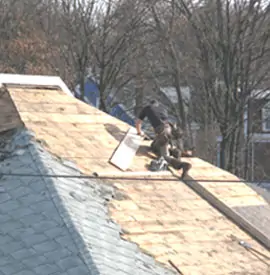
Deck Repair. I mentioned above that this roof had been leaking when my customers called me. The reason was that some of the sheathing near the eaves was pretty close to bark mulch and had to be replaced—and there’s nothing to it but to do it. Replace 1-by boards with the same kind of 1-by boards or cut 3/4-inch OSB to fit. I also found a number of boards that had simply broken at knots and had to be replaced so we had a solid nailing surface for the shingles.
Plasti-Roof
If I was a full time roofer, I’d own a massive blue-poly tarp to dry roofs in. Alas, I’m not, so I used some of my 200-foot roll of plastic as my tarp. It worked great for drying the roof in overnight—even better, really—because I was able to screw it right down to the roof deck and lap shingles. I used 2-by-4s as battens and got a nice, if only temporary, seal to the weather.
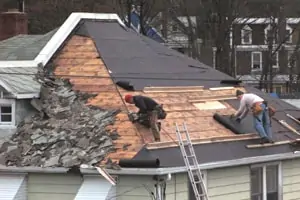
Black Paper
As soon as I could clear a roof plane, I papered it with 30-pound felt. And if I had my druthers, I would have nailed it all with cap nails, because hammer tackers (for staples) often puncture the paper and can create leak points. However, the clock ticked fast, so I combined some cap nails—to hold the paper down if the wind blew hard—and staples, so I could get the thing papered fast. It worked nicely.
Shingle Time
With the shingles off and staged for hauling, I was finally ready to roof—my favorite part of this paid adrenaline fix.
Edge It. Step one is to install an aluminum drip edge, which I did from a ladder along the eaves. I tucked it under the paper and nailed it along the top edge. No fuss no muss.
Shingles. While you can cut your own starter strips from full shingles (as we did back in the old three-tab days), I simply used starter shingles. They saved a ton of time. Make sure to follow the directions on the packaging to ensure the proper offset from the shingles you’re using.
On the front and back planes of the roof, I started my sets (or shingle ladders as some people call them) from the straight edge formed by the parapet between each half of the duplex. Once I had a set (a ladder of shingles with each ascending shingle cut 6 inches back from the one below it) I cruised across the roof plane. Once that set was done I started another. I found this to be the fastest, most efficient method for me.
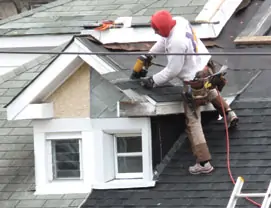
I hasten to add that I integrated step flashing against the vertical parapet and dormer, as I would on any standard roof with a vertical penetration.
On the main roof plane, bordered on the left and right not by a square edge but by a hip rafter, I started my sets in the center.
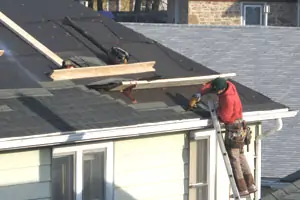
The set that ran left to right was just like any other—I offset the shingles and went to town. The set that ran right to left, however, was a little different. Because the set ran up the roof plane like a flight of stairs, I had to tuck the ends of the shingles headed to the left under the shingles that were already there. It was no big deal, and this enabled me to work on large runs of shingles in both directions on the roof—especially nice for the first 1/2 dozen courses, which are most easily installed from a ladder.
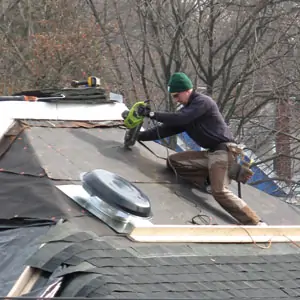
At the highest, most central point in the main roof plane is the spot for the attic fan. While the pros at my roofing supplier were of mixed opinions that an attic fan lengthens the shingle life (ideally, attic fans help the roof system breathe), they were all in agreement that a fan lowered the summertime temp. And while I could get a solar-powered fan, my customer chose a hardwired unit from GAF.
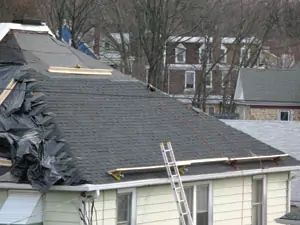
At each hip, I ran the shingles wild over the side. After they were all installed, I snapped a line straight up the hip rafter and then trimmed them all off with a circular saw set to depth.

Along each hip rafter I cut shingle caps from color-matching three-tab shingles. You can use a utility knife for this, but forget that! I hogged through stack after stack using my circular saw and a blade I never want to see again. It was tough on the saw, but it saved me hours.
On the final, exposed nail head on the last shingles, I used BlackJack roof sealant to seal them from the weather. Don’t skip or skimp on this step.
Final Clean-Up
I started my clean-up on the roof and worked my way down. I blew any remaining debris off the new roof with my gasoline-powered blower. Next, I cleaned out the gutters. As part of the gutter clean-out I dragged a garden hose topside and shot it down each downspout to make sure they were clear. Good thing I did, because one of them was totally clogged. Spraying it out with a hose prevented a call-back.
Fine Tooth Comb. I made sure to “fine-tooth comb” the yard, especially the driveway and street—anywhere there might be nails and tires. And once I did a visual inspection, picking up what I could see, I used a stiff broom to sweep the area. I wrapped up using my gasoline powered blower to make triple sure there weren’t any nails or debris.
Haul Away. I paid 80 bucks a ton to dispose of the shingles at a local transfer station, and we had just a little over 2 tons of material. We trucked the material in my 5-by-10-foot Star utility trailer that I’ve rigged up with sides. I love that little trailer. It is a total workhorse.
The shingles were DemoBag-ed. When I ran out of those, I used 3-mil plastic contractor bags, several of which I had to double-bag because they couldn’t handle the combination of sharp contents and weight.
Surprise. If I were to do this again, the only thing I’d do different is protect the items in the attic of the house I worked on. See, dust and debris found its way through the gaps in the roof’s deck boards, coating everything in the attic. It’s also worth pointing out that if you cut a ridge vent into a standard roof, the same thing will happen. Beware of this and take appropriate measures. At the very least, if you’re doing this for a client, warn them it’ll happen.
This roof took about 11 days of prep, actual work and weather delays. While I did most of the work alone, another worker really helped for four of the 10 days and was well worth paying for.
By the end of my rip and run, I felt good, but I had run out of gas. I’m looking forward to a nice, inside and low-to-the ground trim project.
Editor’s Note: Mark Clement is a remodeler and author of The Carpenter’s Notebook, A Novel. www.TheCarpentersNotebook.com. He lives in Ambler, Penn.



